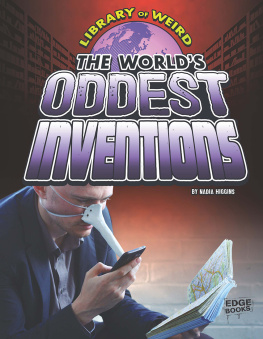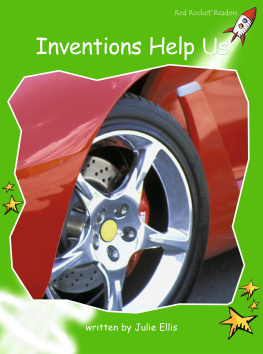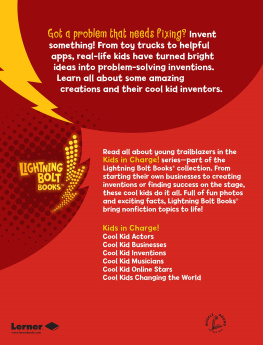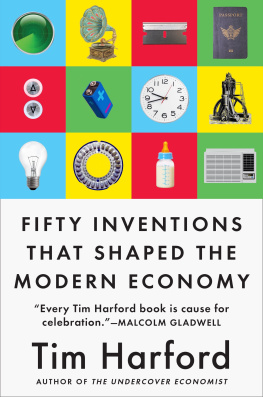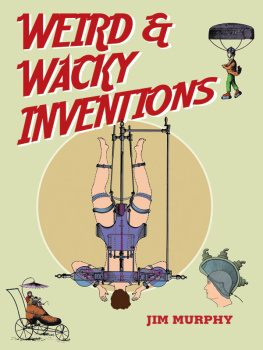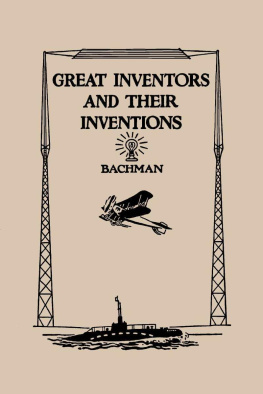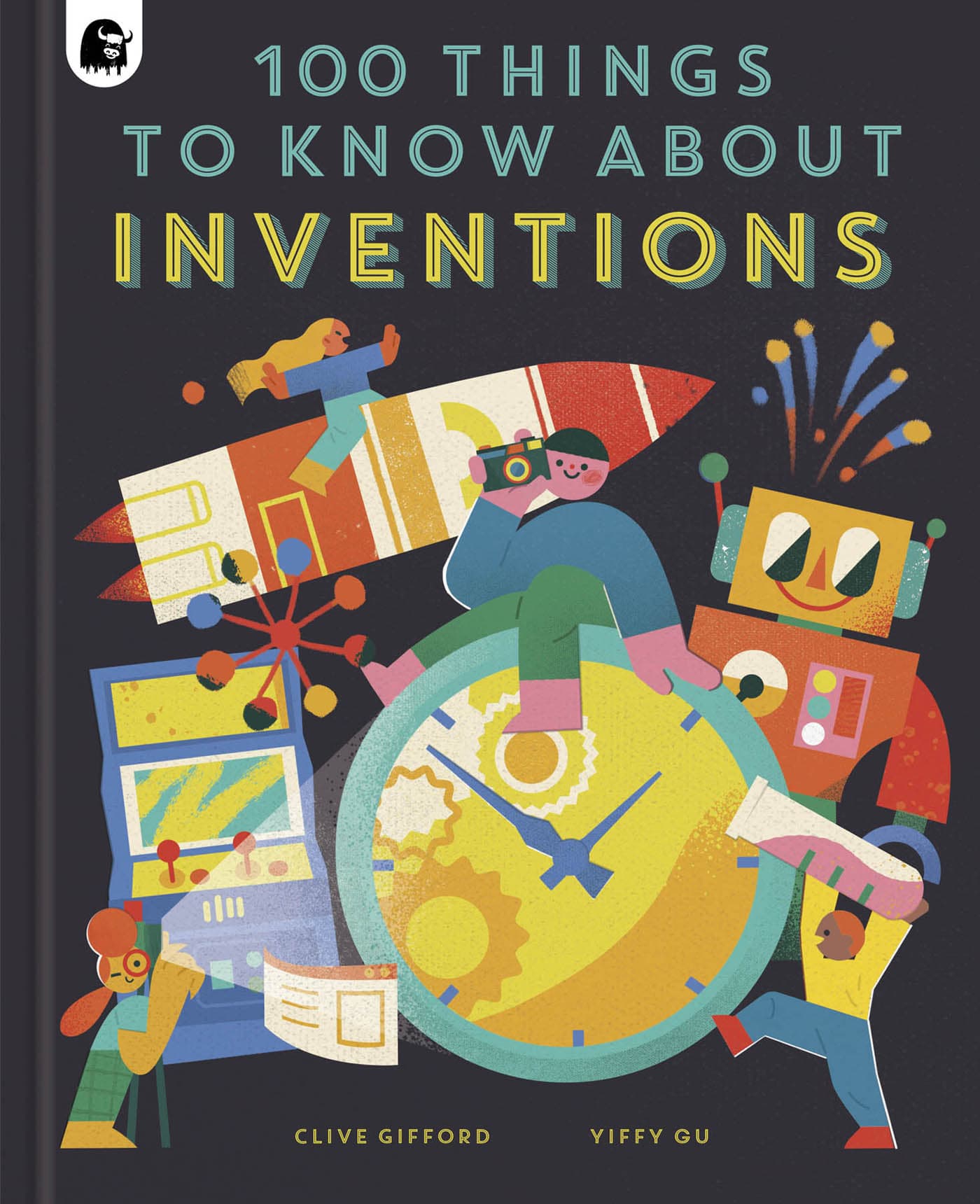Contents
Page List
Guide
Cover
100 THINGS
TO KNOW ABOUT
INVENTIONS
CLIVE GIFFORD
YIFFY GU
CONTENTS
INTRODUCTION
Every day, when you switch on a light, computer or radio, ride your bike, write a note or open the fridge, you are using objects and materials that didnt exist centuries earlier. These inventions didnt spring out of thin air theyre all the work of ingenious, hardworking and sometimes, downright lucky, inventors! Some inventions come in a sudden flash of inspiration, whilst others take many years of hard graft to make them work. Many inventions do not succeed, but when they do they have the potential to transform the way many people live.
This book celebrates the importance of innovations by examining 100 key examples of inventions, big and small. Some have changed the world, while others have made daily life a little bit easier or more rewarding. All have fascinating and sometimes surprising stories to tell and will give you lots to think and talk about.
So what are you waiting for? The world of inventions is just a page turn away!
WHEEL
Many inventions evolve out of new ways of using existing things. In Mesopotamia (present day Iraq), 5,5006,000 years ago, people created simple potters wheels by spinning circular slabs of wood or stone positioned parallel to the ground. Around 3,500 BCE, some bright sparks began placing wheels on their side and inserting a rod through the middle as an axle, so the wheel could turn. Wheels encounter far less friction than an object that is dragged across the ground, so when fitted to carts pulled by oxen or mules wheels made moving people, crops and other goods around quicker and easier.
SKATES
Belgian Joseph Merlin had a smashing time when parading his new invention at a London masquerade party in 1760. He played a violin whilst gliding through the rooms on wheeled plates attached to his boots a demonstration which ended abruptly with him smashing both an expensive mirror and his violin! Despite Merlins mishap, roller skating caught on, especially after the invention of the 2x2 (or quad skates) by New York furniture dealer Joseph Plimpton in 1863. Plimptons skates featured four wheels fitted to a plate that could lean left or right, allowing skaters to turn by shifting their body weight.
STEAM
In 1698, Englishman Thomas Savery invented an engine, which produced power by boiling water, turning it into steam that expanded with force. Saverys engine and those that followed mostly worked as pumps removing water from mines. In 1764, Scotsman James Watt began a long series of major improvements to increase the power and usefulness of steam engines. In 1781, Watt invented a system that converted the straight up and down movement of a steam engine into a rotary (turning) movement, perfect for driving millwheels and other machinery. Watts innovations transformed steam engines into versatile power sources for industry and transport.
LOOM
A loom is a machine that weaves yarn or long threads together to make cloth. In the 1760s, new machines were spinning more yarn than ever before. Edmund Cartwright devised machinery to speed up the process. He built his first basic power loom in 1784. Later versions wove cloth three times faster than a person using a handloom! Power looms were originally driven by waterwheels, but when waterwheels were replaced by steam engines, loom factories could be located anywhere, not just beside rivers. By 1850, there were 250,000 power looms at work in England alone, producing vast amounts of cloth.
CRANE
Rope running over a wheel forms a device called a pulley. When a number of pulleys are used together, people can lift heavy loads using a lot less effort! The ancient Greeks used the amazing power of pulleys to invent the first cranes in the 6th century BCE. Pulleys and ropes that were fitted to a tall, strong, wooden frame enabled heavier loads to be lifted than before, such as large stone blocks or marble statues. The Romans then developed cranes powered by people walking on large wheels. These human-powered cranes could easily lift big loads of four or more tonnes.
LEGO
Danish carpenter Ole Kirk Christiansen set up Leg Godt, meaning play well, in 1934. The company produced and sold wooden and later plastic toys. In 1949, Christiansen introduced the businesss first plastic building bricks, which were redesigned as LEGO in 1958. These hollow plastic blocks interlock due to their round studs on top, allowing infinite building combinations. Amazingly, just six eight-studded bricks can be put together in over 915 million different ways! Moulded from tough plastic since 1964, more than 70 billion bricks and accessories are sold each year. Bricks made today will still work with those produced in 1958!
PLOUGH
Around 6,0006,500 years ago, people in ancient Egypt began using something called an ard or scratch plough to prepare their farm fields. A stout, pointed stick was attached to a frame and pulled by cows or oxen. The stick dug into the soil and broke up hard, baked ground, bringing nutrients to the surface and letting water in. Ploughing produced long, shallow furrows in which seeds could be planted. This ground-breaking tool helped increase the amount of crops grown. Whilst more complex metal ploughs have since been developed, simple wooden scratch ploughs are still used in some places today.
LAWNMOWER
Grass was once cut very slowly using handheld scythes or grazing animals, until an English engineer spied a cylinder-shaped cloth-trimming machine in a cloth mill around 1830. Edwin Beard Budding placed a cylinder with blades at the front of what would become the first lawnmower, which linked to a roller at the back. As the mower was pushed, the roller turned, moving the cylinder and blades, which trimmed the grass. Mowers gained motors in the 1900s, and in 1995 a Swedish company introduced the first solar-powered robot lawnmower, which could cut grass by itself without anyone needing to push it!


